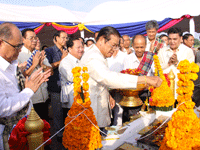
If last year’s political highlight in Laos was the Southeast Asian Games, this year is all about milestones of official anniversaries. A few weeks ago, August 13th, it was the 60th anniversary of the Lao Front for National Construction (Neo lao sang xat), formed as the Free Lao Front (Neo lao issara) in 1950. Last week it was the 35th anniversary of ‘Uprising Day’, August 23rd. And, most of all, November’s That Luang Festival will see the official marking of the 450th anniversary of Vientiane being made ‘capital’ of Laos. This last event is without doubt the highlight: a new ring-road, the 450th Anniversary Road, is being built around the outskirts of the city, new parks are being opened, and trees being planted. This is clearly a big deal.
Whereas the SEA Games were a regional event – albeit with nationalist benefits and overtones – and funded by the region, this year’s anniversaries are very much domestic celebrations aimed at reinforcing the historiography of the party-state. Yet there is a similar underlying concern with recognising the onward march of national development under the guiding hand of the Lao People’s Revolutionary Party (LPRP). Like all LPRP historiography, this demands a rather creative take on the Lao past, particularly when it comes to linking pre-modern Lao kingdoms with more recent struggles against France and the United States.
A striking example of such creativity appeared in the Vientiane Times last week in a report on Uprising Day, August 23rd, the day in 1975 on which the Pathet Lao ‘liberated’ Vientiane. The report effectively reproduces a speech given on the occasion by Somsavat Lengsavad, Standing Deputy PM and chairman of the organising committee for the 450th anniversary of Vientiane becoming ‘capital’. Of course, Somsavat was chairman of the SEA Games organising committee, suggesting further continuity between last year’s big event and this year’s celebrations.
In his speech, Somsavat recalled that in the mid-16th century ‘Burmese feudalists’ threatened to invade the Lane Xang kingdom: “To resist the invasion by Burmese feudalists, King Xaysetthathirath moved the Lao capital from Luang Prabang to Vientiane in 1560 and Vientiane has been the nation’s capital ever since.”
So far so normal – even accounting for the lack of any ‘nation’ of Laos until 1949, or the fact that Vientiane became a ‘capital’ in 1900 at the earliest (when it was reborn as the seat of the colonial administration). The more interesting bit, linking the royalist ingenuity of 1460 to the revolutionary milestone of August 23rd 1975, came at the article’s end:
After France left, America came to colonise Laos. Lao people stood up to fight against America under the leadership of the Lao People’s Revolutionary Party and finally liberated the country in 1975.
[Somsavat said:] “Today, we celebrate August 23 with pride. Throughout the past 450 years, our capital has experienced both prosperity and damage, but Lao people have never surrendered or become discouraged to fight for their nation’s liberation.” (See the full report here)
There you have it: just as they would later do so in 1975, the Lao were fighting for their nation’s liberation in 1460.
In a similar vein, the Vientiane Times carried a story the same day on a stone-laying ceremony for an 8 metre-statue of Chao Anou, which will be unveiled during the 450th anniversary celebrations in November. Again the officiating minister was Somsavat (see picture). But unlike Chao Anou’s ill-fated attack of Siam, which has long been part of Lao historiography, this is the first time (certainly since 1975), that the anniversary of Vientiane’s foundation as ‘capital’ has been officially marked, or even mentioned as a day of national significance.
The revolutionizing of the pre-modern Lao past recalls the construction of a statue of yet another pre-modern Lao king, Chao Fa Ngum, and associated commentary early in the 2000s. The recent surge in official events – both big (SEA Games, 450th Anniversary) and small (August 23rd, etc) – also shows how the the party-state continues to capitalise on its hold on power and Laos’ improving economic fortunes with increased boldness in historiographical matters, no matter how much creativity is required.
As well as any other comments, I am particularly interested to know of specific ways in which the 450th anniversary is being marked, and if preparations for the event are generating any popular enthusiasm.
 Facebook
Facebook  Twitter
Twitter  Soundcloud
Soundcloud  Youtube
Youtube  Rss
Rss 